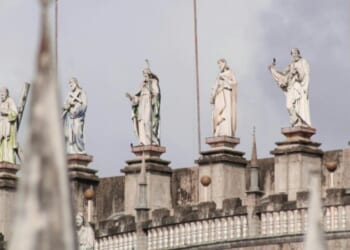While the Rafale series is one of the top 4.5-generation jets in the skies today, they are certainly not invulnerable.
In May, Pakistan and India inched close to engaging in a full-blown war. Exchanges in violence beginning with the Pahalgam tourist attack culminated in fighter jets downed and dozens killed on both sides of the conflict. Islamabad initially claimed to have shot down six of New Delhi’s fighters during the flare-up, which would amount to a big feat for the Chinese jets that allegedly were responsible. While this claim was not verified at the time, India’s military chief acknowledged that an unspecified number of its fighters were indeed shot down by Islamabad during the skirmish.
India Responds to the Jet Shootdown
In an interview with Bloomberg, the chief of defense staff of the Indian Armed Forces implied that at least two of its aircraft were downed during exchanges of fire between the two adversaries, noting that “What is important is why they went down. That is more important for us. And what did we do after that? That’s more important.” Chauhan added “The good part is we were able to understand the tactical mistake which we made, remedy it, rectify it and then implement it again after two days and flew all our jets, again targeting at long range.”
Among the jets taken out by Pakistani forces were allegedly Indian-piloted Rafale fighters. Just one week prior to the outbreak of violence between the two historic foes, New Delhi penned a deal with France to procure 26 Rafale fighter aircraft for $7.5 billion. Produced by France’s Dassault Aviation, the Rafale jet series continues to surge in popularity across the globe. Designed to serve as a successor to the Dassault Mirage 2000, the Rafale was borne from the multinational Eurofighter Typhoon effort. The collaborative jet platform developed by Italy, Spain, West Germany, the UK, and of course France was considered a huge feat at the time. However, France still opted to pursue a fully domestic jet program, culminating in the Rafale.
The Origins of the Rafale
The Rafale’s formal introduction to service in the early 2000s represented a major milestone for France, proving that the nation was equipped to field a homegrown fighter platform on its own. With air supremacy as the focal point of the program, the French fighter was designed as a multirole aircraft capable of performing aerial reconnaissance, interdiction, and ground support. Over the years, significant upgrades have been incorporated into the platform, allowing it to retain an edge over newer-generation successors. The introduction of the Thales TLS 2000 navigation receiver and other key sensors particularly enhanced the Rafale’s prowess. In terms of ordnance, the French jet is quite lethal. Each Rafale can sport payloads of more than 9 tons on 14 hardpoints, including ASRAAM and AMRAAM air-to-air missiles, as well as HARM, Apache, Maverick, and PGM100 air-to-ground missiles.
While the Rafale series is undoubtedly one of the top 4.5-generation jets in the skies today, they are certainly not impervious. The fact that Pakistan may have been able to shoot down one of these jets indicates pilot error or other shortcomings that need to be rectified before another skirmish erupts.
About the Author: Maya Carlin
Maya Carlin, National Security Writer with The National Interest, is an analyst with the Center for Security Policy and a former Anna Sobol Levy Fellow at IDC Herzliya in Israel. She has by-lines in many publications, including The National Interest, Jerusalem Post, and Times of Israel. You can follow her on Twitter: @MayaCarlin. Carlin has over 1,000 articles published over the last several years on various defense issues.
Image: Falcons Spotters / Shutterstock.com

















